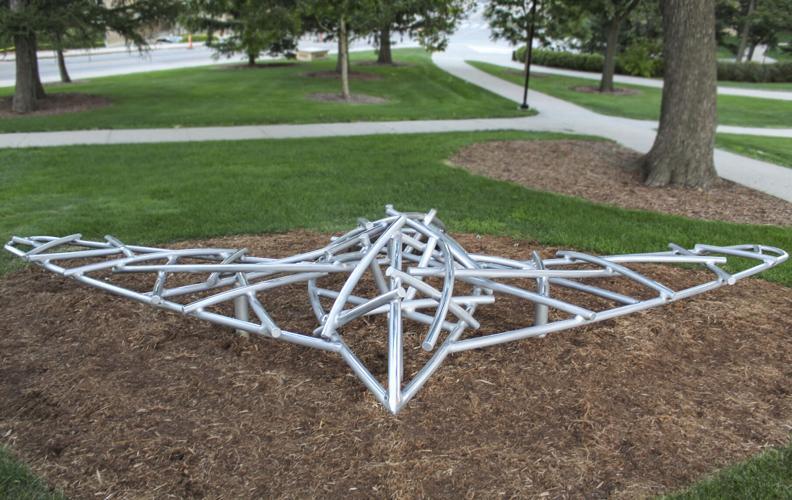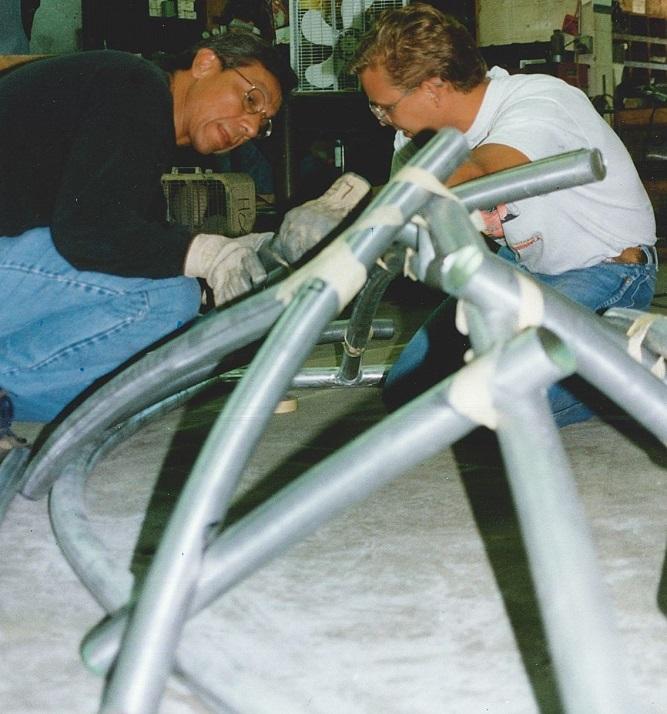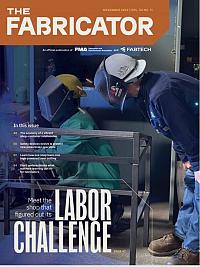Editor
- FMA
- The Fabricator
- FABTECH
- Canadian Metalworking
Categories
- Additive Manufacturing
- Aluminum Welding
- Arc Welding
- Assembly and Joining
- Automation and Robotics
- Bending and Forming
- Consumables
- Cutting and Weld Prep
- Electric Vehicles
- En Español
- Finishing
- Hydroforming
- Laser Cutting
- Laser Welding
- Machining
- Manufacturing Software
- Materials Handling
- Metals/Materials
- Oxyfuel Cutting
- Plasma Cutting
- Power Tools
- Punching and Other Holemaking
- Roll Forming
- Safety
- Sawing
- Shearing
- Shop Management
- Testing and Measuring
- Tube and Pipe Fabrication
- Tube and Pipe Production
- Waterjet Cutting
Industry Directory
Webcasts
Podcasts
FAB 40
Advertise
Subscribe
Account Login
Search
Aluminum bird sculpture returns after 26 years
Fabricator discusses University of Wisconsin–Madison sculpture, working with late artist
- By Rafael Guerrero
- November 26, 2023
- Article
- Metals/Materials

Truman Lowe’s “Effigy: Bird Form” was installed at the University of Wisconsin-Madison in 2023, about 26 years after it was first fabricated in the Madison area. UW-Madison Facilities Planning & Management
Just north of Van Hise Hall on the University of Wisconsin-Madison campus, “Effigy: Bird Form” hovers over the ground (or at least appears to).
The aluminum sculpture, which weighs more than 900 lbs., is one of the newest attractions on campus—but it isn’t new. In fact, artist Truman Lowe and Wisconsin-based Hooper Corp. worked on the sculpture in the Madison area more than two decades ago.
Lowe’s sculpture has had multiple homes throughout its existence, including a one-year stay at the White House. But after 26 years, “Effigy” has come home to the University of Wisconsin, a place where Lowe is known for his art and contributions both to the university and the area’s Native American community.
“I never thought it would be back here, back home,” said Larry Sailing, who worked with Lowe on the sculpture.
A Unique Opportunity
Sailing has spent 34 years in Hooper Corp.’s custom metals department. It is among the smaller departments at the company, an electric power and mechanical contractor headquartered in DeForest, Wis., with regional offices in Colorado, Florida, and Ohio. Nowadays, Sailing is shop foreman, and much of the company’s metalwork comprises custom projects for residential, commercial, and pharmaceutical customers.
Early in his career, Sailing had the opportunity to work with Lowe on this metal sculpture—a memory that remains fresh in his mind, and rightfully so: “Effigy” was displayed at the White House’s Jacqueline Kennedy Garden as part of a yearlong exhibition. It’s something Sailing describes to others as a “once-in-a-lifetime opportunity.”
Lowe was well known locally and beyond; his work had been exhibited in the U.S., Canada, Europe, Africa, South America, and New Zealand. While he worked in wood mostly, he did venture into metals like aluminum.
Jo Ortel, author of “Woodland Reflections: The Art of Truman Lowe,” described his work as minimalist yet elegant.
“It looks deceptively simple,” she said.
With this sculpture, Lowe wanted to honor his Ho-Chunk roots and Ho-Chunk upbringing in Wisconsin and the Upper Midwest.
“He wanted to recognize the ancient [Ho-Chunk] history that he had a personal tie to and also pay homage to the [effigy] mounds that have been lost through farming and urban development,” Ortel said.
The sculpture is 20 ft. wide, 12 ft. long, more than 4 ft. tall, and about 18 in. off the ground. According to descriptions, Lowe designed it in the shape of a bird hovering above the ground, its aluminum pieces woven together in an ethereal lattice design.
Ortel said Lowe meant for it to be seen from above. In particular, he wanted it to be seen by the president as he left or arrived at the White House via the Marine One helicopter.
“He thought it was great that [the Clintons] be reminded constantly of the Midwest and also this big, deep history of the Midwest,” she said.
Dozens of 2-in. solid aluminum rods were welded together; also included were welded hollow aluminum pieces for the sculpture wingtips. The sculpture required more than 200 hours to fabricate, Sailing estimated; this included welding, grinding, and polishing.
Sailing said he admired Lowe’s approach to “Effigy.” For instance, he recalled how Lowe would set up the rods on top of one another, look at them, and come back the next day and reset them.
“It was kind of neat to see his vision of what he saw,” he said. “He was an amazing person, soft-spoken, easy going, pretty laid back, a great sense of humor. We had a lot of fun working together. We were proud of our accomplishments.”
It wouldn’t be the last time the two men worked together, as Lowe sought Sailing and Hooper’s help on three other pieces.
Honoring Truman
Lowe passed away in 2019, so he never saw "Effigy” return to Madison. Efforts have been made to get more of his work into the public eye, including in Madison.
The University of Wisconsin celebrated the sculpture’s return with a dedication in September 2023.
“Truman was a beloved and inspiring teacher and mentor whose work was deeply rooted in his Ho-Chunk heritage. It’s a special occasion to welcome Truman’s artwork back home to UW-Madison,” said Carla Vigue, the college’s director of tribal relations, in a news release.
Oftentimes, fabricators don’t get to revisit their work because it’s a one-time thing or it gets replaced years later. In this case, Sailing had a chance to work on the sculpture again, 26 years after his first encounter with it.
Last summer, he spent about 12 hours polishing and cleaning the sculpture ahead of its installation. He followed Lowe’s specifications from several years earlier, such as polishing the top of the aluminum to a shine but keeping the bottom of it natural. It helped that there were decades-old photos as well that documented the steps they took to bring the sculpture to life.
“It weathered quite well,” Sailing said of the sculpture’s condition. “It wasn’t that bad.
“It is a huge honor for me to see it back in Madison again and to be able to work on something that Truman and I worked on at the beginning of my career—and here I am now at the tail end of my career,” he added. “It's an amazing feeling and [I’m] lucky to have that opportunity.”
Lowe left a lasting legacy at the University of Wisconsin. His positions there included art professor, art department chair, and Native American Studies program coordinator. He was also a UW graduate, earning degrees from the Madison and La Crosse campuses. The La Crosse campus even opened the Truman T. Lowe Center for the Arts in 2022.
Sailing and Ortel agreed that Lowe would have loved seeing one of his most famous works return to a place near and dear to him.
“It really belongs here; it belongs in Wisconsin where all the mounds are,” Ortel said. “It's even more symbolic that it’s here on the campus because he loved [the University of Wisconsin].”
About the Author

Rafael Guerrero
2135 Point Blvd.
Elgin, IL 60123
(815)-227-8242
Rafael Guerrero. was named editor of The Welder in April 2022. He spent nine years as a journalist in newspapers in the Midwest and Pacific Northwest, covering topics and communities in central Illinois, Washington, and the Chicago area.
subscribe now

The Fabricator is North America's leading magazine for the metal forming and fabricating industry. The magazine delivers the news, technical articles, and case histories that enable fabricators to do their jobs more efficiently. The Fabricator has served the industry since 1970.
start your free subscription- Stay connected from anywhere

Easily access valuable industry resources now with full access to the digital edition of The Fabricator.

Easily access valuable industry resources now with full access to the digital edition of The Welder.

Easily access valuable industry resources now with full access to the digital edition of The Tube and Pipe Journal.
- Podcasting
- Podcast:
- The Fabricator Podcast
- Published:
- 04/16/2024
- Running Time:
- 63:29
In this episode of The Fabricator Podcast, Caleb Chamberlain, co-founder and CEO of OSH Cut, discusses his company’s...
- Trending Articles
Tips for creating sheet metal tubes with perforations

JM Steel triples capacity for solar energy projects at Pennsylvania facility

Are two heads better than one in fiber laser cutting?

Supporting the metal fabricating industry through FMA

Omco Solar opens second Alabama manufacturing facility

- Industry Events
16th Annual Safety Conference
- April 30 - May 1, 2024
- Elgin,
Pipe and Tube Conference
- May 21 - 22, 2024
- Omaha, NE
World-Class Roll Forming Workshop
- June 5 - 6, 2024
- Louisville, KY
Advanced Laser Application Workshop
- June 25 - 27, 2024
- Novi, MI




























